This article covers
What is a tide pool?
A tide pool is an isolated pocket of seawater found in the ocean’s intertidal zone. Tide pools can be found in depressions along the shoreline of rocky coasts. During the low tides, these tide pools are filled with seawater that gets trapped as the tide recedes. Many marine creatures will also be trapped in these small basins. This makes tide pools the best natural classroom for studying sea lives such as snails, barnacles, mussels, sea anemones, sea stars, crustaceans, seaweed, and small fish.
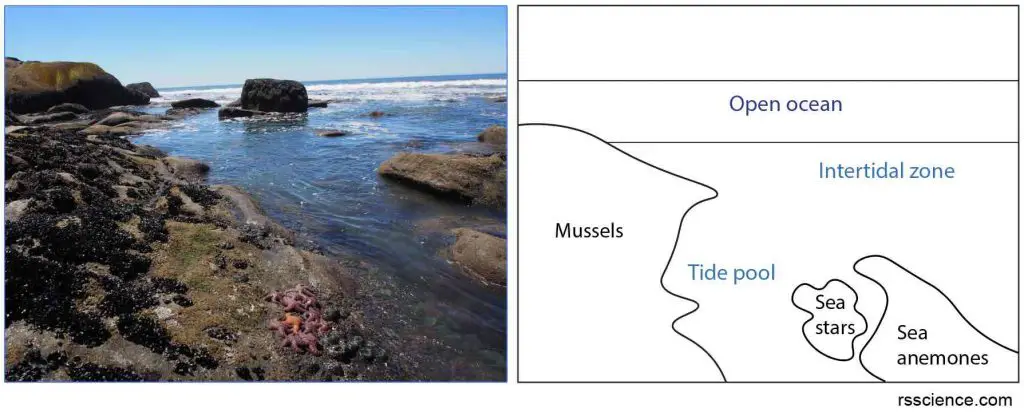
[In this image] Tide pools are pockets of saltwater left behind during a low tide, filled with a wide variety of marine animals and seaweed. Tide pools present the perfect opportunity for people to easily observe ocean lives. The left picture was taken in Olympic National Park, WA. Could you see three groups of tide pool animals in the picture? These three groups are mussels, sea stars, and sea anemones, as illustrated in the right image.
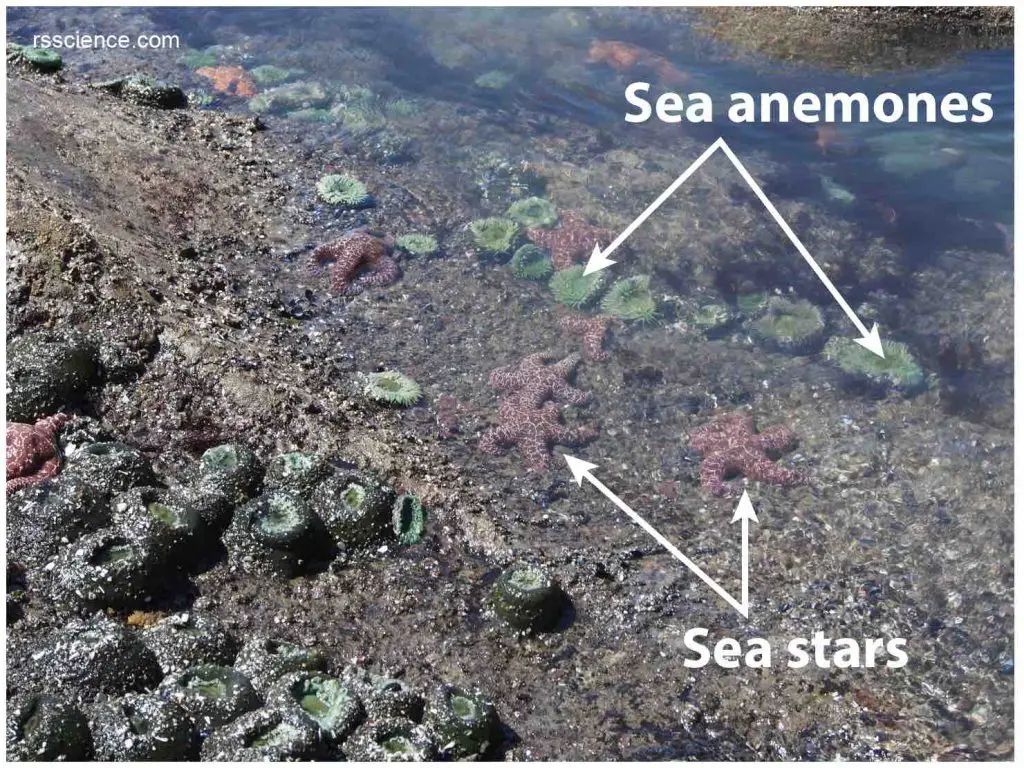
[In this image] A closer look to see these red sea stars and green sea anemones. Olympic National Park, WA.
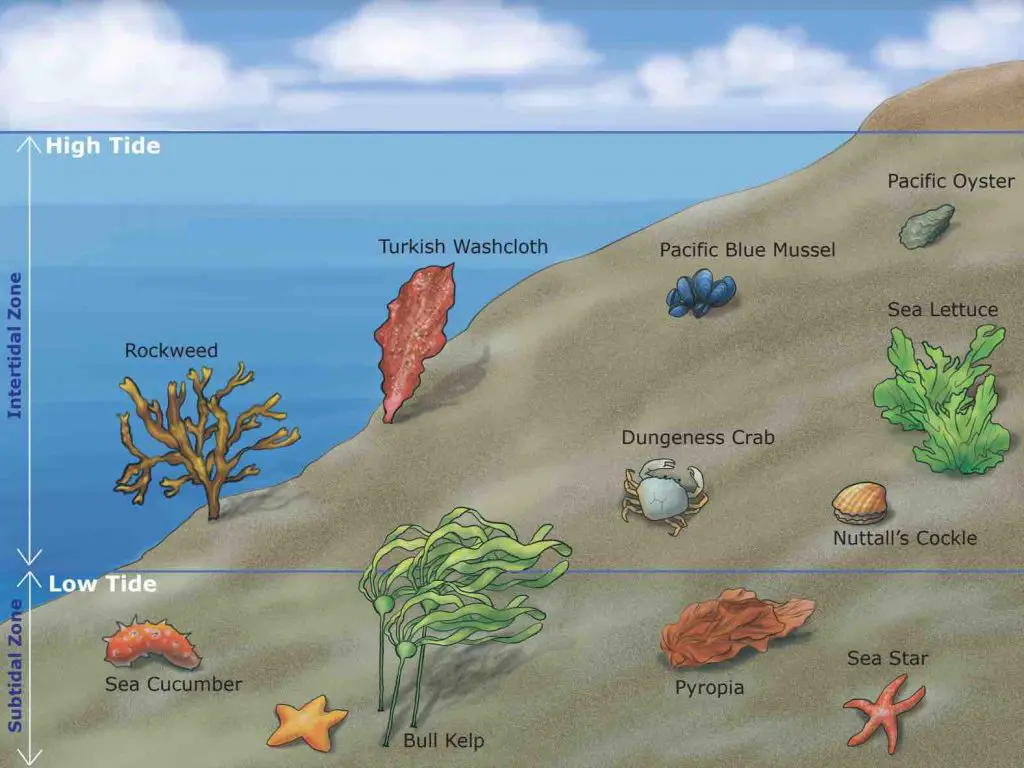
[In this image] The intertidal zone is the area where the ocean meets the land between high and low tides. It hosts a rich ecosystem of marine shorelines.
Photo credit: https://www.cshan-visuals.com/
How do these ocean creatures live in a tide pool?
Tide pools typically range from several inches to a few feet deep and a few feet across. During a low tide, the residences of tide pools must endure hours of isolation from fresh seawater. As you can imagine, the tide pool soon becomes a rugged environment where is exposed to the sun, low oxygen, increasing water temperature, and predators such as wading birds.
To survive in this rugged environment, tide pool inhabitants often cling very tightly to any rock to which they can adhere (for example, barnacles and limpets). Other sea lives may hide beneath sands, rocks, or seaweed. Having a strong shell can also protect these animals from predators and help keep their bodies moist. Examples are sea snails and mussels. The hard exoskeleton of crabs, lobsters, and shrimp offers the same advantage as well.
The space in a tide pool may be limited, but the food there is plentiful. Every wave during a high tide delivers fresh nutrients and microscopic organisms, such as planktons, to support and replenish the pool’s food chain. These microscopic organisms nourish the smallest animals, which, in turn, sustain the larger ones.
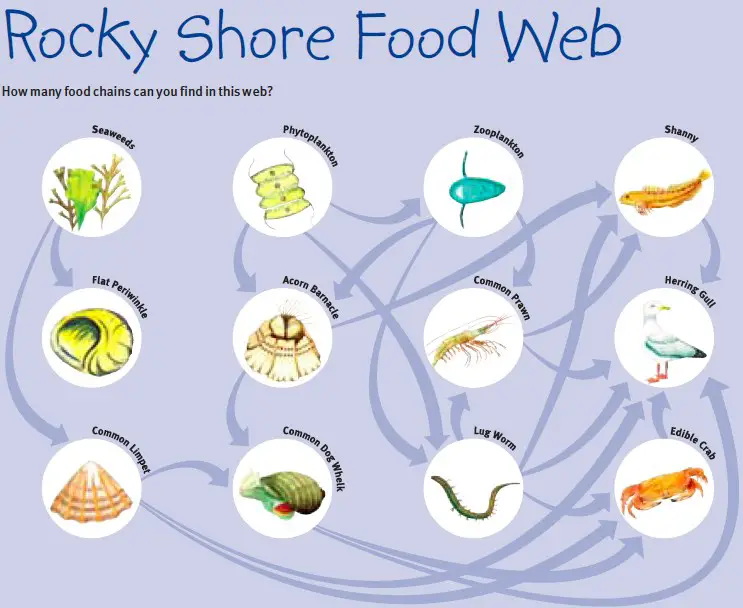
[In this image] Marine food web in the ocean’s intertidal zone.
Photo credit: Ypte
8 Tips for your first tide pooling
Exploring these tide pools – an activity known as “tide pooling” — is a fun and educational activity that’s especially popular among children. If you give it a whirl, here are a few tips for you:
- The best time to visit tide pools is at low tide. You can find the local tide schedule here.
https://marineweather.net/
http://tbone.biol.sc.edu/tide/ - Going barefoot isn’t a good idea. Wear shoes that you don’t mind getting wet, such as sports sandals, old sneakers, or rubber rain boots.
- Find footholds on bare rocks, which are less slippery than those covered with algae and seaweed.
- Return animals exactly where you found them. If you peek under a rock, put the rock back where and as you found it.
- Don’t remove attached animals like limpets, barnacles, or sea anemones off a rock.
- Don’t bring any animal home. Many of them are very sensitive to the salinity. It may also be illegal to do so in many areas.
- Bring a bag with you to pick up any trash on the beach.
- In these places where there are tide pools, you’ll find pocket-sized marine life field guides at the local bookstore or gift shops. Bring one of these along will help you identify any critters you find and learn about them.
Here are some downloadable guides:
Seacoast Science Center Atlantic Ocean Rocky Shore Guide
Learn What Lurks in a Massachusetts Tide Pool
Tide pool creatures you may encounter
I. Mollusks
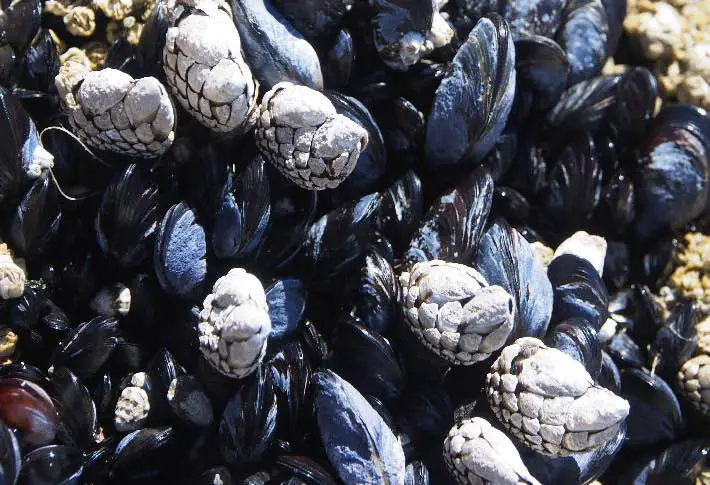
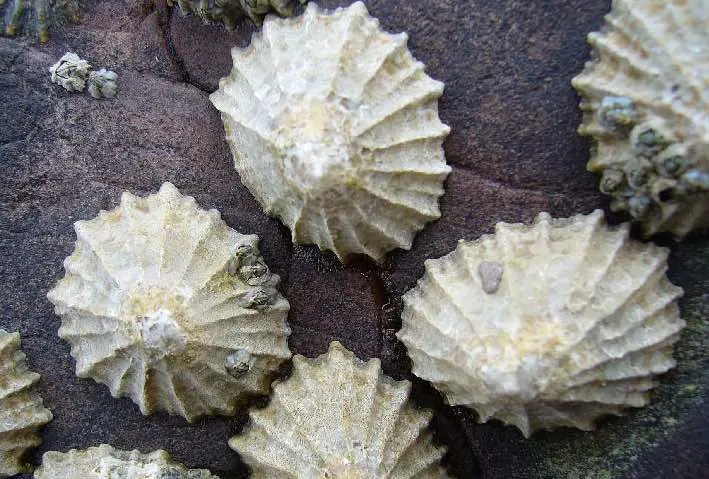
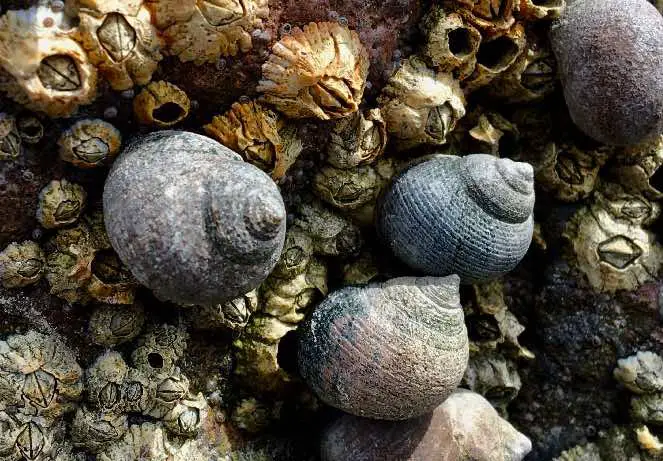
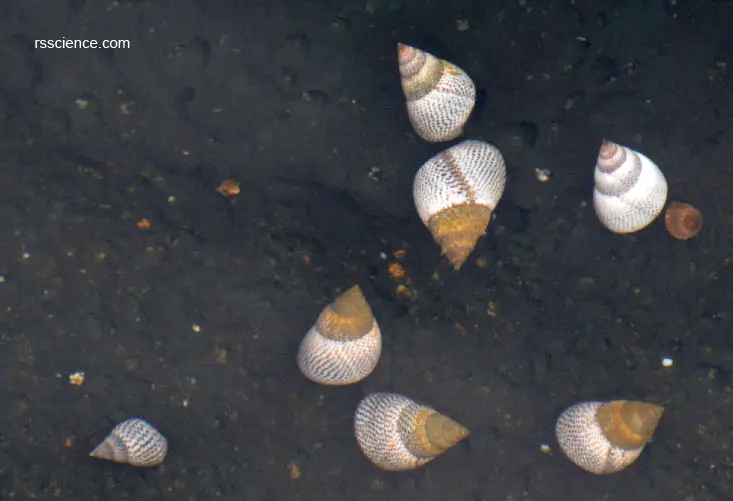
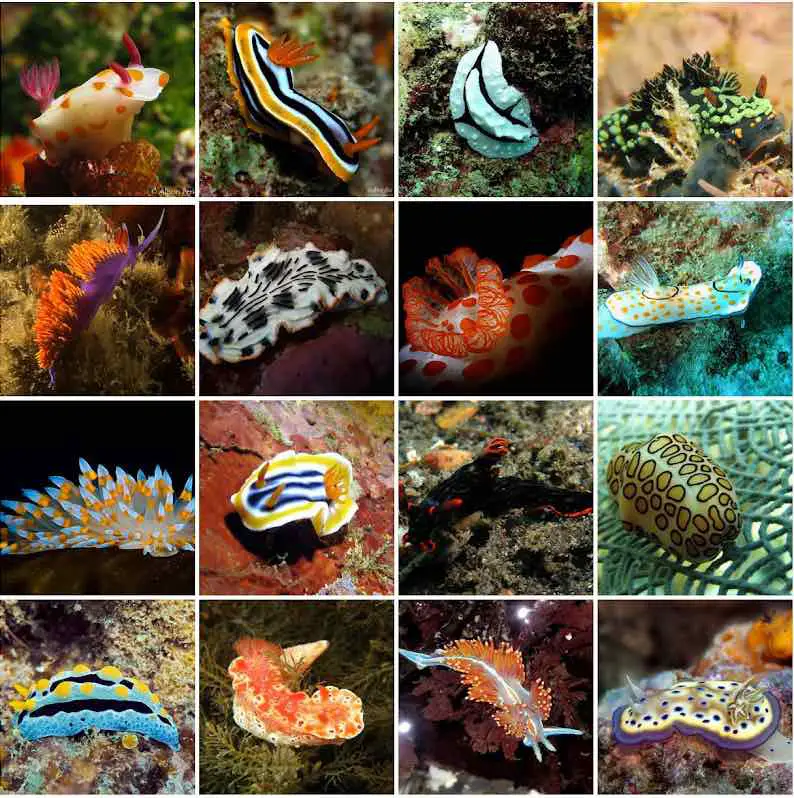
II. Crustaceans
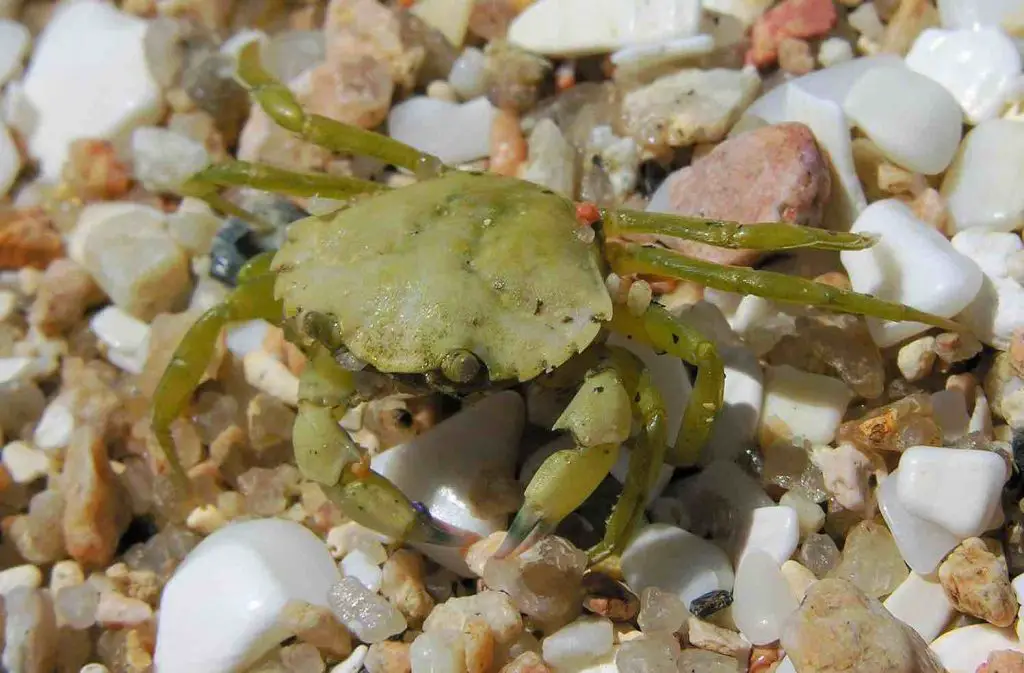
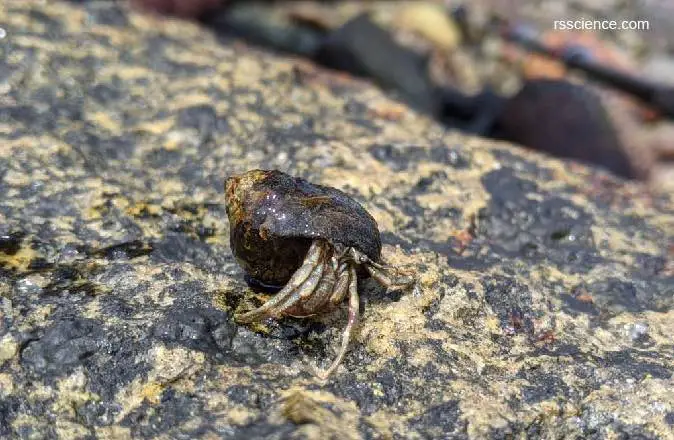
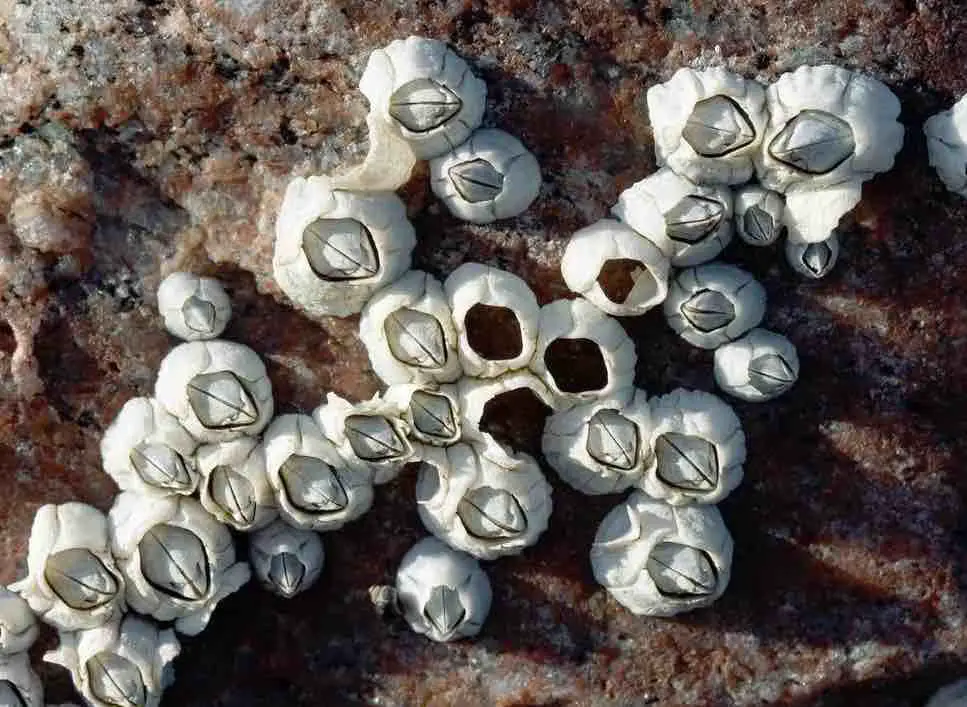
III. Echinoderms
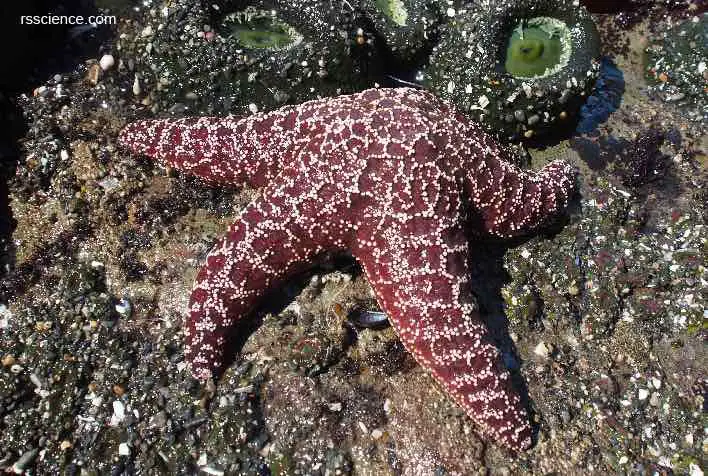
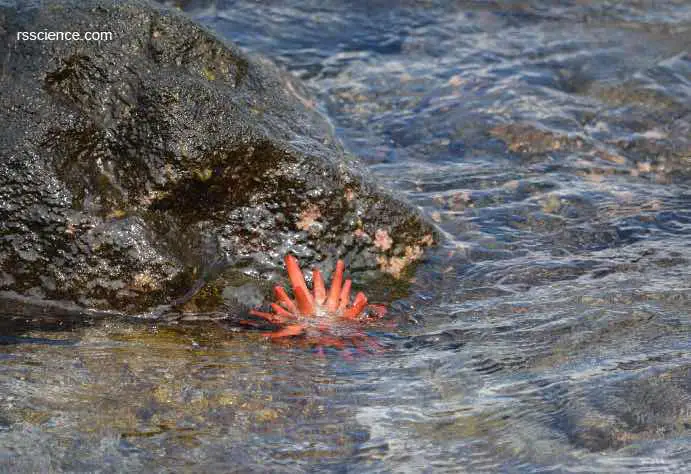

IV. Cnidaria
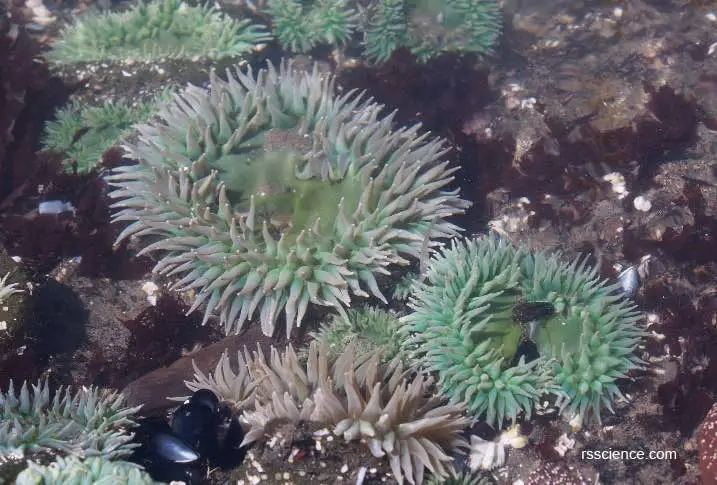
V. Chordates
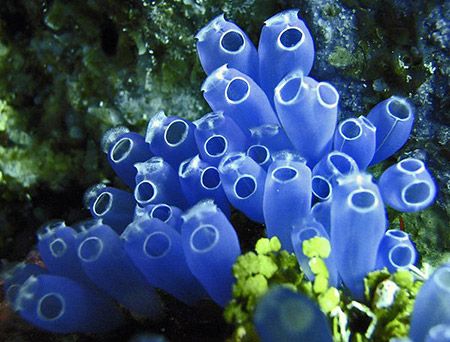
VI. Vertebrates
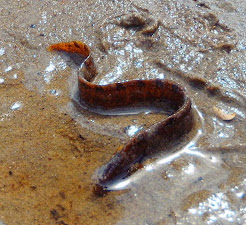
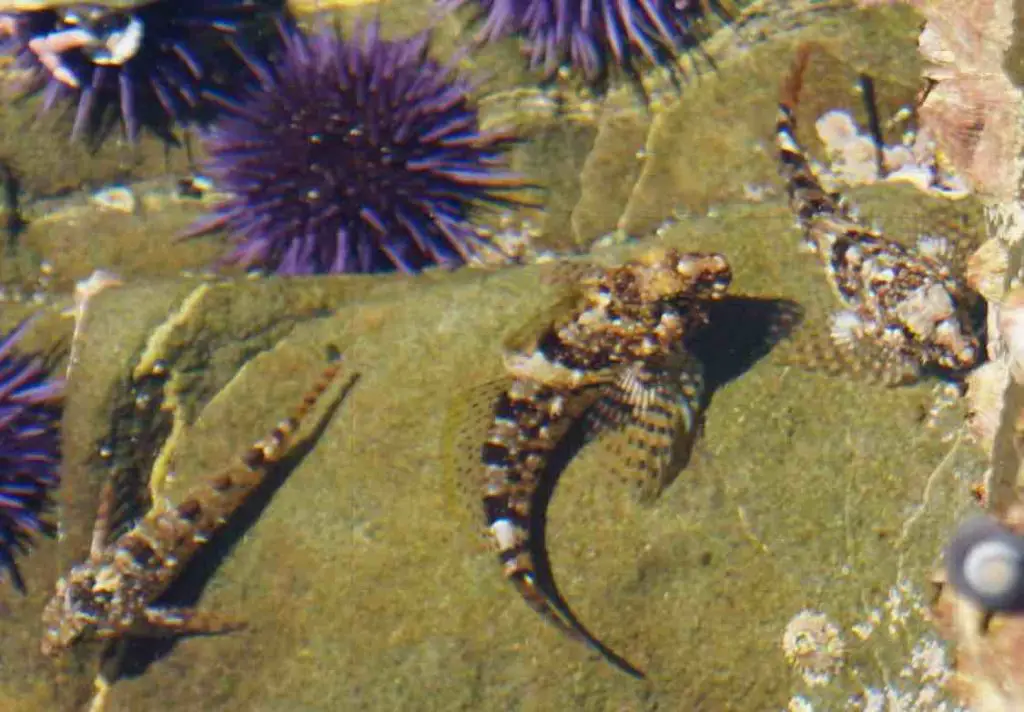
VII. Seaweed
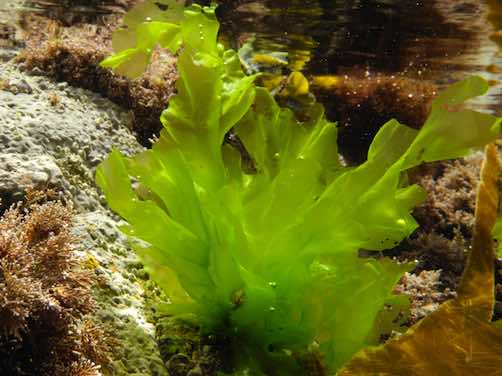
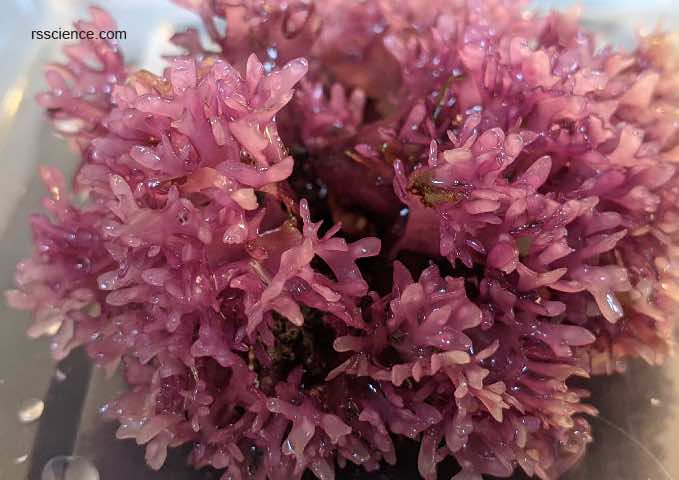
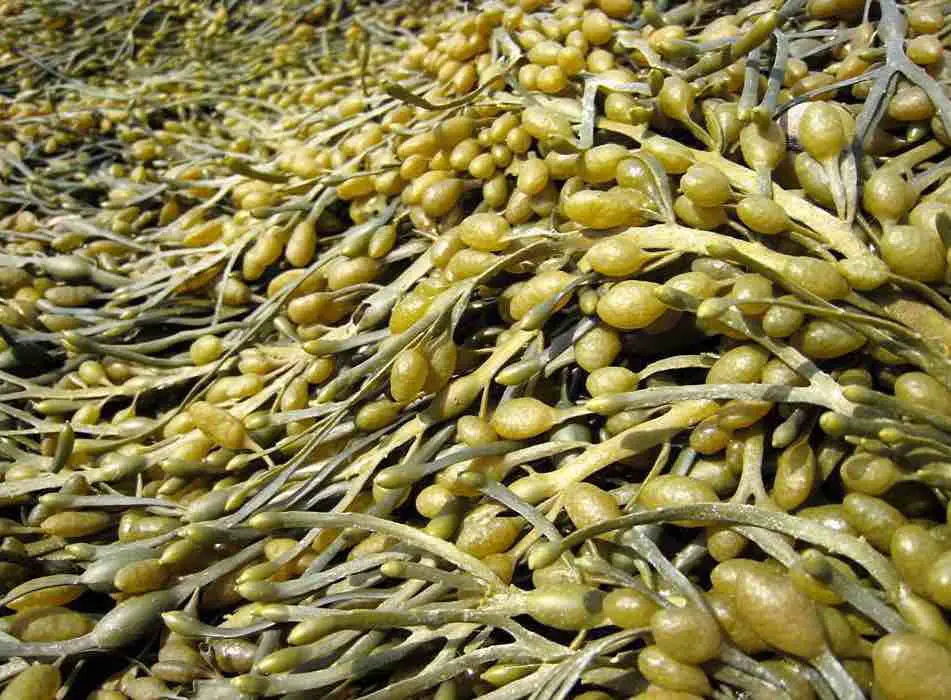
Barnacles
Barnacles are one of the most common tidal pool animals. Barnacles are often overlooked because they are tiny and immobile. In fact, they are pretty amazing creatures.
Barnacles’ bodies encase in rough, circular, white shells. However, they are not a member of Mollusks (typical Mollusks include snails and clams). Barnacles are small crustaceans, meaning they are cousins of crabs, shrimps, and lobsters. Unlike most crustaceans, however, adult barnacles are sessile – they can’t move. Their shells provide perfect protection from predators and being dried out. When under the water (say during a high tide), they will open their shells and sweep their legs through the current, ushering plankton (tiny, floating organisms) into their mouth.
Barnacles can produce fast-curing cement to glue themselves to rocks, usually in the company of many barnacles. This natural substance is among the most powerful glues known to exist. In fact, researchers are trying to figure out if and how it can be harvested or reproduced for commercial use.

[In this image] Acorn Barnacles anchoring on a rock.
Photo credit: Oceana
Blue mussels
Blue mussels are mollusks encased in teardrop-shaped shells. They are typically found growing in clusters, attaching to rocks, the ground, or other stable surfaces with strong threads of protein. They’re also a delicious offering on many seafood menus.
They are filter feeders. They pump and filter the water through their gills in order to feed and breathe, so they can improve the water quality.
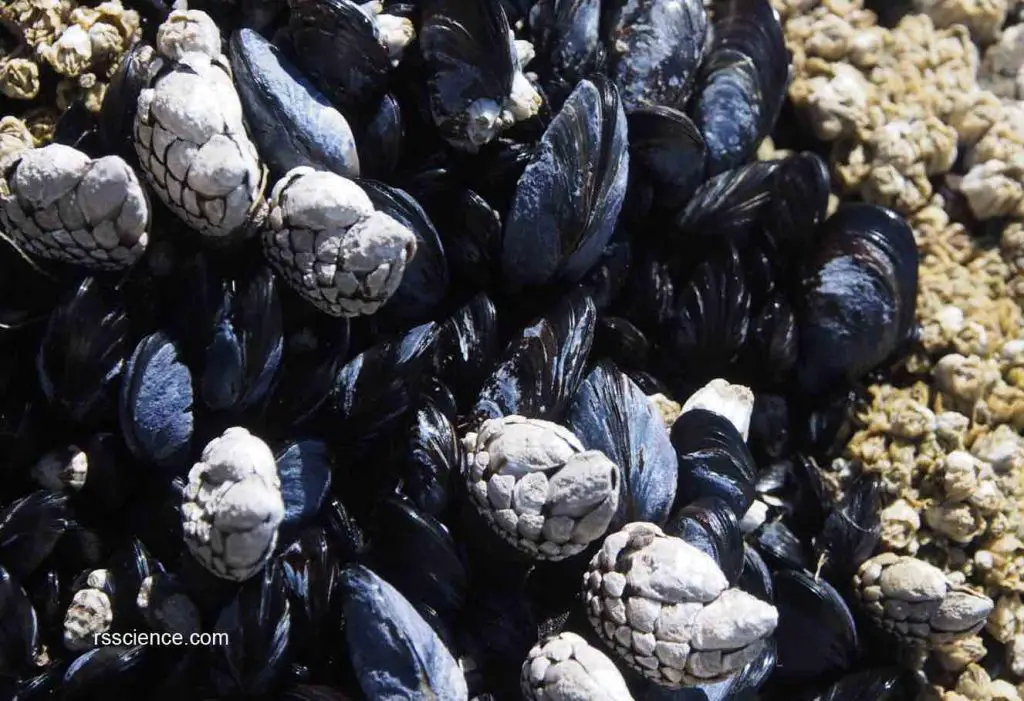
[In this image] A group of blue mussels (blue) and barnacles (white ones).
Tide pool location: Olympic National Park.
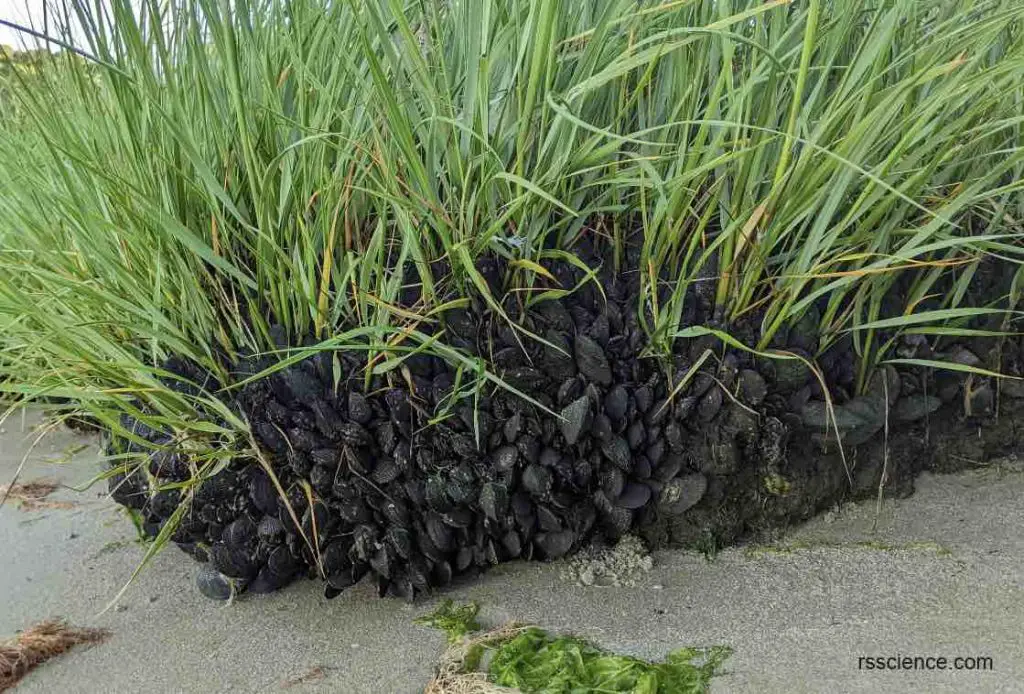
[In this image] A big cluster of mussels grows under the grass.
Tide pool location: Ropes Beach, Barnstable, MA.
Limpets
Limpets are a group of marine snails carrying a conical shell and a strong muscular foot. For limpets, large crabs and sea stars are potential predators underwater and birds are primary threats above. However, the limpet’s shell is shaped in such a way that it is difficult to grasp, and it is thick enough to be difficult to break. It also perfectly covers the entire soft part of the body.

[In this image] Limpets firmly attach themselves to a rock. The shells perfectly protect their soft bodies.
Photo credit: wiki
Periwinkles
Periwinkle is a species of small edible sea snail. They carry a dark and sometimes banded shell. These snails like to graze on algae growing on rocks and seaweed, especially abundant in tide pools. Harvesting periwinkles to eat is sometimes called “wrinkling.”

[In this image] Periwinkles are abundant in almost every tide pool.
Photo credit: Seashore to forest floor
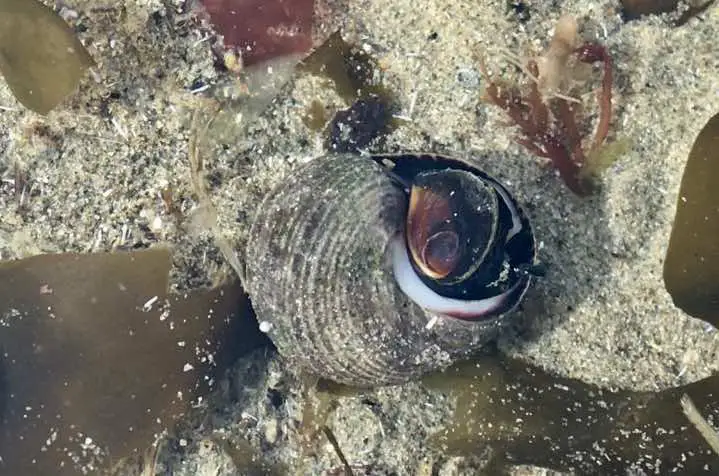
[In this image] Periwinkle uses an operculum to seal up the opening of its shell.
Photo credit: Seashore to forest floor
Dog whelks
Dog whelks are another type of sea snail found in tide pools. Dog whelks are carnivorous (meat-eaters) and commonly eat barnacles and baby mussels. On the other hand, periwinkles are omnivorous (eat both plants and animals). Both periwinkles and dog whelks have round, coiled shells, but the dog whelk shell is longer and more pointed.
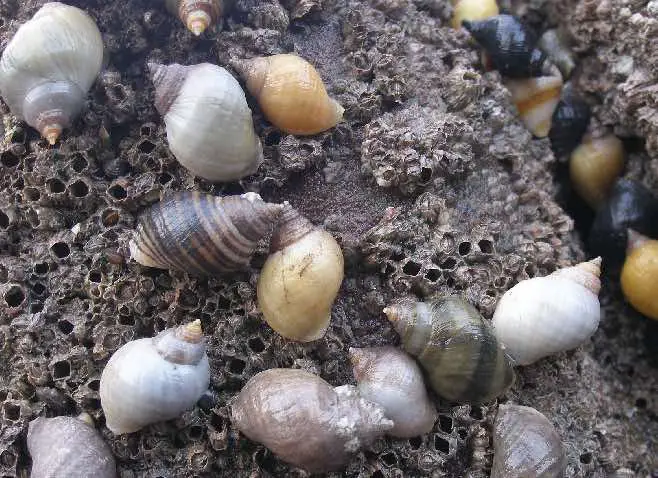
[In this image] A group of live dog whelks on the barnacles which they eat.
Photo credit: wiki

[In this image] Dog whelks with beautiful stripes on their shells.
Tide pool location: Pu’uhonua O Hōnaunau National Historical Park, Big Island, Hawaii.
Sea slugs
Sea slugs or sea hares are sea snails that have lost their shells (or became very small) over evolutionary time. Most sea slugs feed on specific types of red and brown algae. Few of them also feed on other animals.
Sea slugs are often overlooked in tide pools. This is because they are well camouflaged to mimic the color of the rocks they inhabit. Pay attention to soft, white ribbon-like structures glued to the undersides of rocks, you may occasionally find them. Some sea slug species (Nudibranchs) could be very colorful.
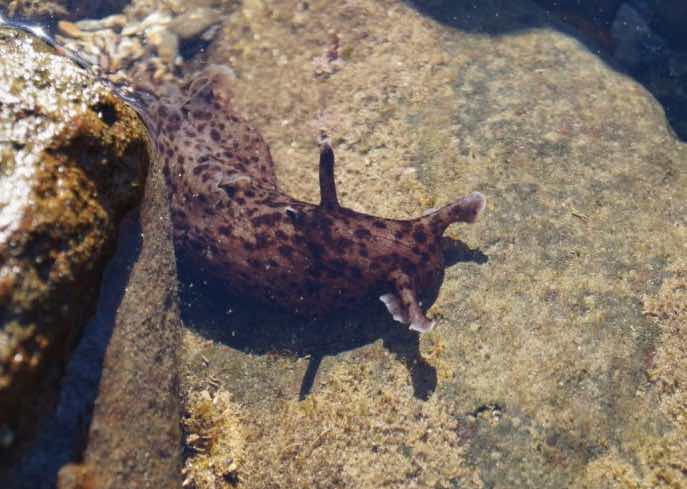
[In this image] Sea slugs could be particularly difficult to see as they blend into the environment very well.
They sometimes acquire color from their food. For example, a species of sea slug prefers to graze on specific kinds of red algae in their habitation. The pigments in these red algae then contribute to the overall body color of these sea slugs, making them camouflage better into the environment.
Photo credit: California Tide Pools

[In this image] Nudibranchs, which also belong to sea slugs, have an amazing variety of colors and shapes. However, they usually live on reefs.
Photo credit: wiki
Sea stars
Also known as starfish, sea stars are one of the most recognizable creatures of the coastline. They can often be found in both shallow and deeper water, and sometimes in tide pools. Sea stars have colorful, star-shaped bodies. Most of them have five arms, although some deep-sea species can grow as many as 50 arms.
Many aquariums and ocean science centers have sea stars in their touching pools. You can feel their spiny skin on the back. The arms are covered with tiny tube feet with suckers that allow the animal to slowly creep along the ocean floor.

[In this image] A red sea star with a white-dot pattern on its spiny skin.
Tide pool location: Olympic National Park.
Sea stars like to eat mollusks such as clams, oysters, and snails. The sea star eats by attaching to prey and extending its stomach out through its mouth. Sea stars are a member of Echinodermata, which is recognizable by their radial symmetry. Sea urchins, sand dollars, sea cucumbers, and sea lilies are all sea stars’ cousins.
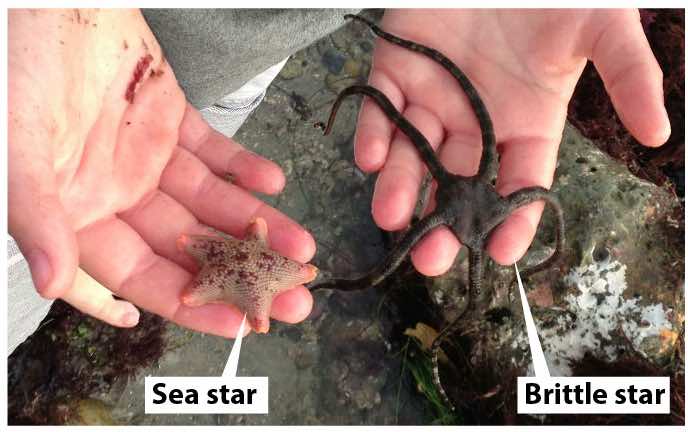
[In this image] Brittle stars, which are cousins to sea stairs, usually have longer arms.
Photo credit: rachelannstock
Sea urchins
As a close relative of the sea stars, sea urchins live in round, spiny shells which are impossible to miss. They move slowly using tiny tube-like feet. Sea urchins are herbivores (feed on plants). They like to graze on seaweed. If you can turn them over (be careful), you will see the mouth at the center of their body. You may even see five little white teeth in a circle.
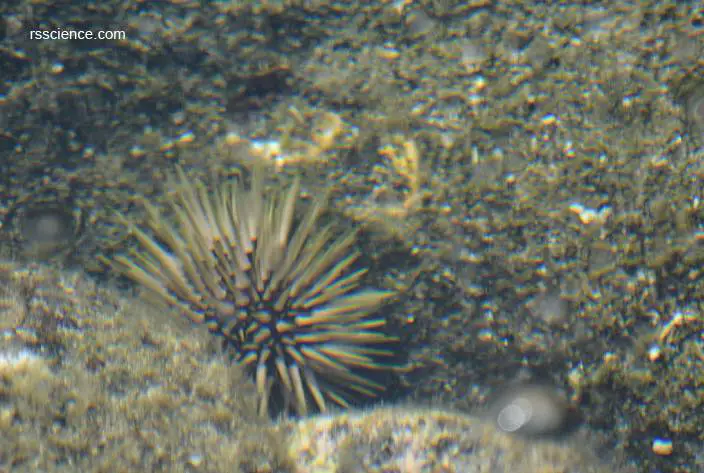
[In this image] A sea urchin behind a rock.
Tide pool location: Pu’uhonua O Hōnaunau National Historical Park, Big Island, Hawaii.

[In this image] A different kind of sea urchin with thick, blunt spikes.
Tide pool location: Pu’uhonua O Hōnaunau National Historical Park, Big Island, Hawaii.
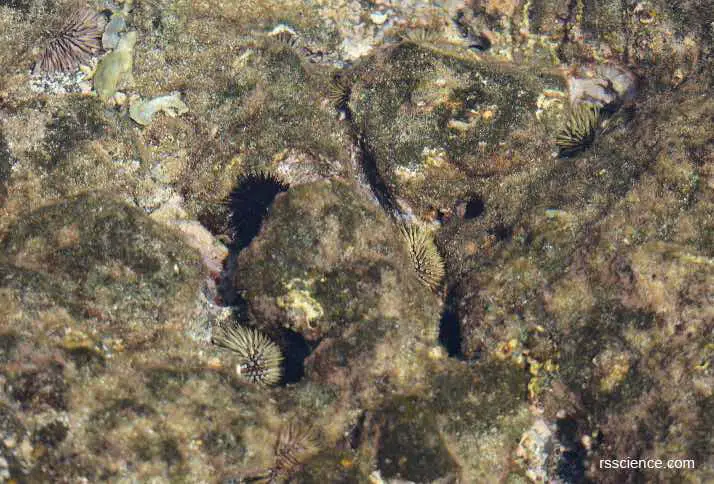
[In this image] There are nine sea urchins in this picture. Could you find them?
Tide pool location: Pu’uhonua O Hōnaunau National Historical Park, Big Island, Hawaii.
Sea cucumbers
Even though they are named after a vegetable, sea cucumbers are animals – related to sea stars and sea urchins. Sea cucumber’s body is covered with tube feet. They use these feet mainly to attach themselves to the rocks or the ocean floor. Modified tube feet around their mouth are used to capture food such as tiny planktons.

[In this image] A sea cucumber.
Photo credit: Global aquaculture alliance
Sea anemones
Sea anemones can be found occasionally in tide pools. Sea anemones are easy to spot because they look like flowers, with their tentacles stretched out like petals to catch their prey.
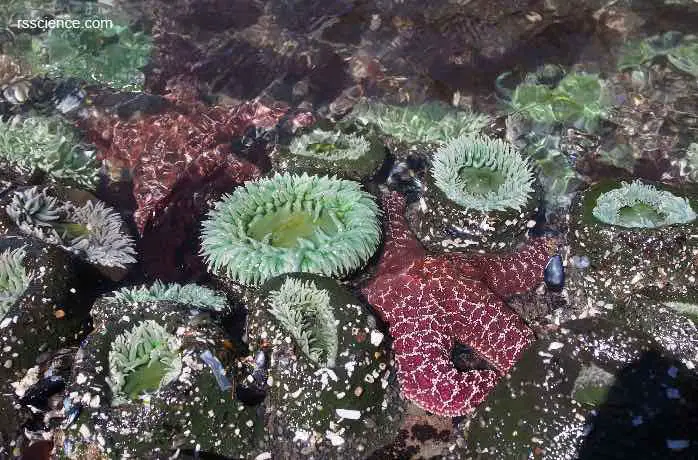
[In this image] Two sea stars sneak into a school of sea anemones.
Tide pool location: Olympic National Park.
Sea anemones are cousins of jellyfish, coral, and hydra. These groups of predatory animals (Cnidaria) have specialized stinging cells, called cnidocytes, which can deliver a sting for capturing prey. Sea anemones can move around if their current location is no longer suitable. It may take a while for them to move but they will eventually get there.
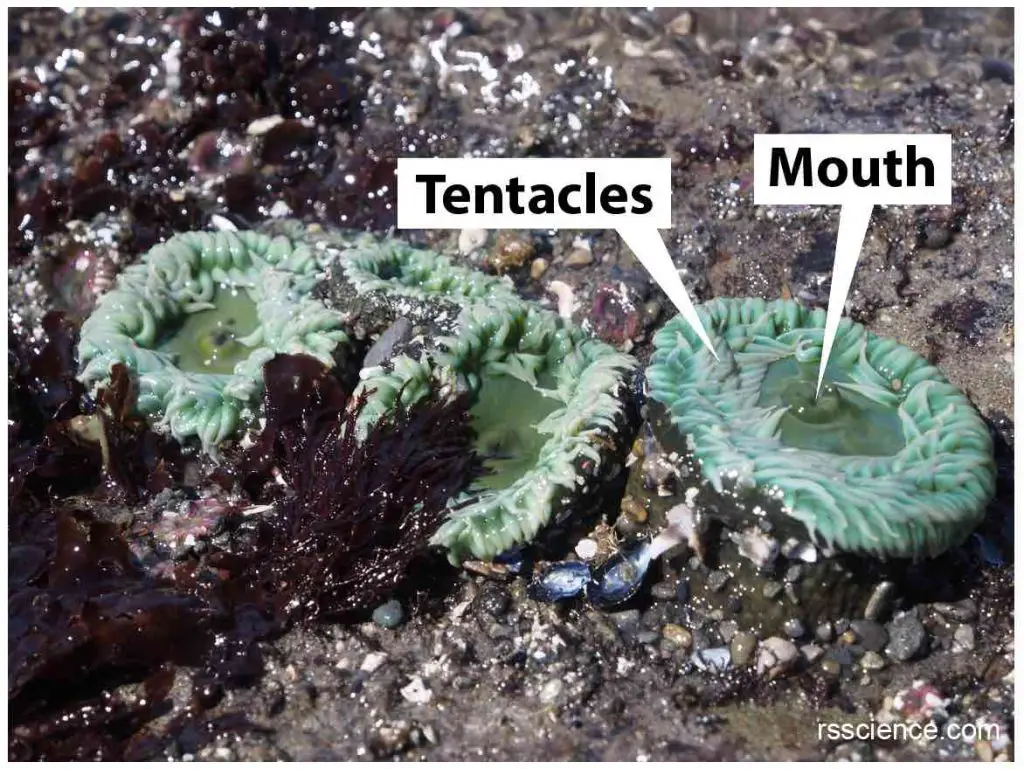
[In this image] You can see the central mouth surrounded by several whorls of tentacles.
Some sea anemones have a very special adaptation that allows them to thrive in tide pools – by having green algae growing inside their bodies. These algae can make energy from the sun by photosynthesis. This symbiotic relationship between algae and sea anemones is beneficial to both. The sea anemones get oxygen, and the algae get protection. These algae also make sea anemones look green.

[In this image] These sea anemones have beautiful green color due to symbiotic algae living inside.
Tide pool location: Olympic National Park.
Hermit crabs
Hermit crabs are small crustaceans that shelter themselves in empty shells left by other mollusks such as periwinkles or dog whelks. They’re fascinating to watch as they crawl around, dragging their shells with them.
Hermit crab’s soft abdomen is curled around the contours of the shell, keeping it securely in place. However, the shell won’t grow as a hermit crab grow up. For this reason, they need to exchange their shells from time to time. They even steal each other’s shells.
Hermit crabs are active tide pool animals and easy to spot. But watch out, it might pinch you with its front claws (one of which is notably larger than the other).
[In this video] A hermit crab living in a periwinkle shell.
Tide pool location: Odiorne Point State Park, Rye, NH.
Crabs
You may find several kinds of crabs of different sizes and colors in tide pools. The most common one is green crabs, though they’re not always green. In fact, young green crabs can display a wide variety of colors and patterns on their shells (depending on their diets and habitation). In the United States, green crabs are actually considered to be invasive species, potentially affecting other local shellfish. Green crabs like to hide in kelps or under submerged rocks.

[In this image] A young green crab showing the common green color.
Photo credit: wiki
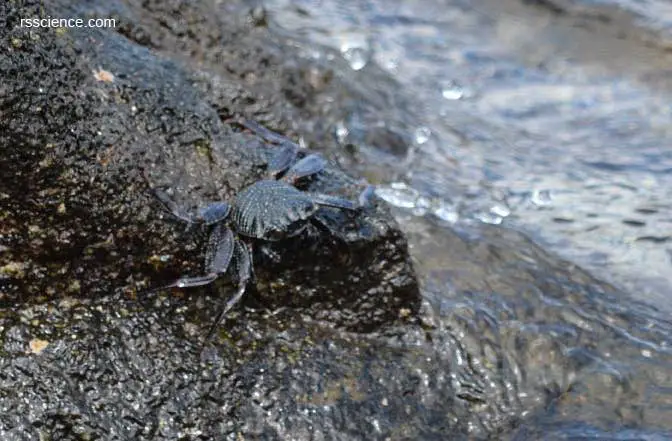
[In this image] A black crab is easily overlooked due to its camouflaging color.
Tide pool location: Pu’uhonua O Hōnaunau National Historical Park, Big Island, Hawaii.
On the east coast of the United States, you can often find other kinds of crabs including Rock and Jonah crabs (both are native), and shore crab (another invasive species). Spider crabs may be found occasionally in a tide pool – they are the ones camouflaging themselves with algae. To differentiate the region’s crabs, it is helpful to take careful note of the shape of the carapace (the shell containing the body of the crab), the patterns on the carapace, and the sizes of their front claws. You can use this ID card to identify invader crabs of the New England coast.
[In this video] A tiny crab we found in a tide pool behind the Seacoast Science Center in the Odiorne Point State Park, Rye, NH.
Sea squirts
Sea squirts (also called Tunicates) get their nickname from their behavior to “squirt” out water when they are removed from the seawater. They are easy to be ignored – look like rubbery blobs, they are actually very advanced animals – much closer to humans than all other creatures we had mentioned on an evolutionary scale!
This is because we and sea squirts both have a spine. Sea squirts belong to the phylum Chordata, which includes all animals (from fish to humans) with a spinal cord. Some sea squirts like to grow together as a group. They may have a colorful looking, making us easily confused with sea anemones or corals.
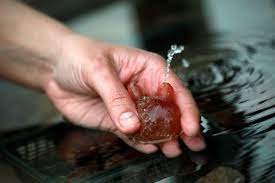
[In this image] A sea squirt “squirts” water in a researcher’s hand.
Photo credit: World economic forum

[In this image] The beautiful color of Colonial sea squirts.
Photo credit: Marinebio
Fish
Small fish, such as mummichogs (also known as killifish or saltwater minnows), tautogs, blennies, gobies, and rock gunnels, may occasionally get trapped in a tide pool.

[In this image] Three common tidepool fish: mummichog, blenny, and goby.
Photo credit: wiki
Fortunately, these tidepool fish are well adapted to this environment. They can survive for a short period of time under altered oxygen, salinity, and temperature during the tidal cycle. Some of them can even leave the water and walk across the rocks on their fins to get back to the ocean.
[In this video] Mudskippers, a member of the goby family, are amphibious fish that can “walk” in the mud as the tide retreat.
Rock gunnels
This eel-like fish (4-6 inches) can often be found burrowed under rocks or seaweed. They can even survive outside the water for a period of time because their slimy skin prevents them from drying out. Also, they breathe through their skin.

[In this image] Rock gunnel’s body is covered by a thick slime layer which is used for keeping it moist while it is out of the water and also for escaping predators.
Photo credit: intertidal-novascotia
Tidepool sculpins
As its name suggests, tidepool sculpin is another type of fish found common in tide pools. Tidepool sculpin has a large head, tapering body, spiny fins, and can grow up to 3 inches. They are tolerant of both brackish water and normal seawater. Tidepool sculpins show great homing ability, returning each time the tide recedes to the pool in which it has taken up residence. They are common on the coast of the northwest Pacific Ocean.

[In this image] Tidepool sculpins and purple sea urchins.
Photo credit: California Tide Pools
Tidepool seaweeds
Seaweeds are often overlooked in tide pools because they are so abundant. However, they are the foundation of a tide pool ecosystem. The term “seaweed” is a general name for plants that grow in saltwater; it includes grass-like plants such as eelgrass as well as all sizes of algae, ranging from microscopic to large enough to form underwater forests. Here, we refer to “marine algae” as seaweed visible in tide pools.
[In this video] Colorful green, red and brown algae dominate shallow rock pools.
Like plants on land, tidepool seaweed is the “primary producer” that harnesses sunlight to create food for animals. In addition, they provide hiding places for small creatures to avoid predators, and as refuges from heavy waves or hot sun. Many of them are harvested by humans as food ingredients, especially in Japanese cuisine.
Below are common seaweed found in tide pools (or on the rock/beach during a low tide):
Sea lettuce (green algae)
Sea lettuce (or Ulva sp.) is one of the most common marine green algae. Sea lettuce has bright green silky sheets and ruffled margins. You can find it attached to rocks in the middle to upper tide zone, or as free-floating plants in quiet tide pools.
Found worldwide, sea lettuce has been used as mulch, animal food, and even as a condiment in soups and salads. However, a bloom of excess sea lettuce can cause “green tides”, releasing chemical substances that are toxic to other marine creatures.

[In this image] Ulva lactuca is an edible green alga that is widely distributed around the world.
Photo credit: The Seaweed Site
Rockweed (brown algae)
Also called bladder wrack (Fucus sp.), these brown algae range from the low tide zone all the way to upper zone rocks where it’s too high and dry for other seaweeds. Rockweed can do so because it can preserve more water in its cells.
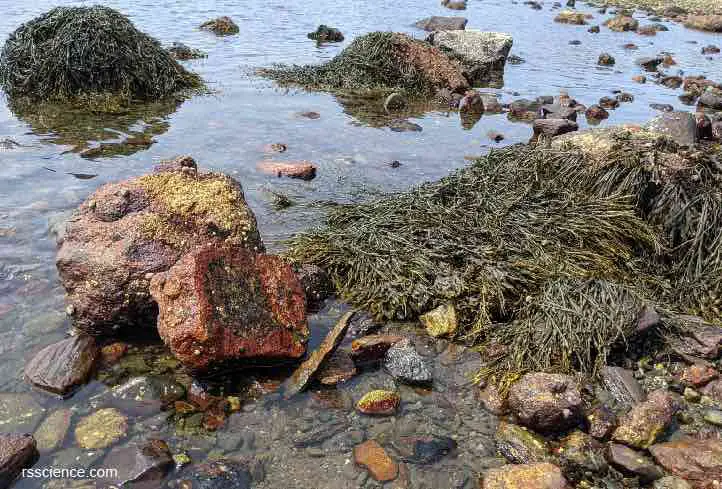
[In this image] A bush of bladder wrack out of the water during a low tide.
Tide pool location: Odiorne Point State Park, Rye, NH.
You are sure to notice rockweed’s distinctive olive-green branches with bladders at the ends. Rockweed uses these air bladders to float during a high tide (giving them access to sunlight and creating a forest under the water) and then lay flat on the rocks when the tide is out. These bladders also contain mucous-like gels and produce reproductive cells.
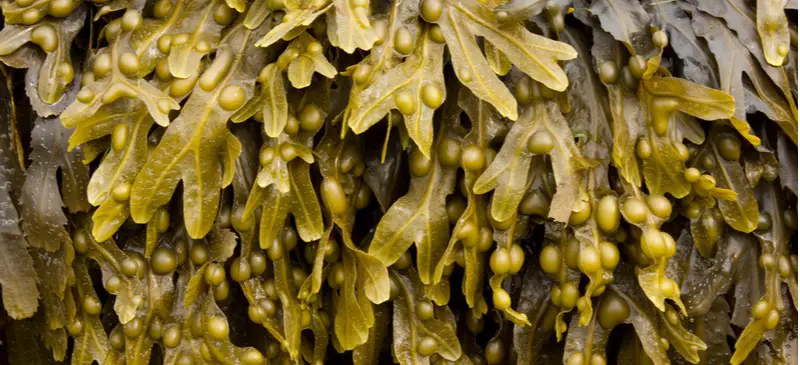
[In this image] Air bladders on rockweed.
Like other marine algae, rockweed provides habitats for many creatures, even fish. We also made good use of rockweed, for example, making alginate for food products, cosmetics, and pharmaceutics.

[In this image] Knotted wrack, another common brown algae, also has air bladders.
Photo credit: iNaturalist
Red algae
The red algae include some of the most delicate and beautiful seaweed you can find in a tide pool. The red color of these algae results from the pigments phycoerythrin and phycocyanin, which are absent in green algae. The cell wall of red algae can be used to produce agar and carrageenan.
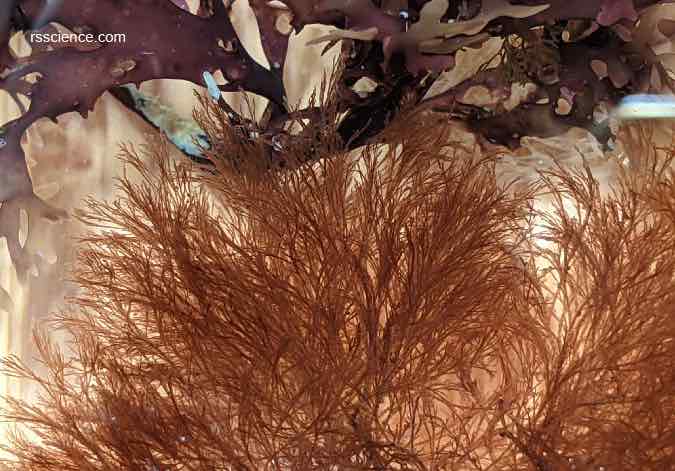
[In this image] Two kinds of red algae we found on the New Hampshire coastline. The bottom one could be Polysiphonia elongate or Callithamnion corymbosum.

[In this image] A bunch of Irish moss, a small reddish-purple, fan-shaped seaweed.
Tide pool location: Odiorne Point State Park, Rye, NH.
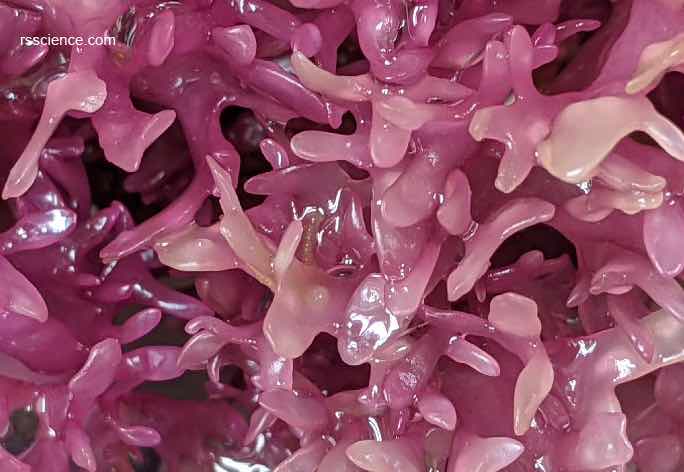
[In this image] Look closer and you can see the Irish moss also has bladder-like bumps on its fan.
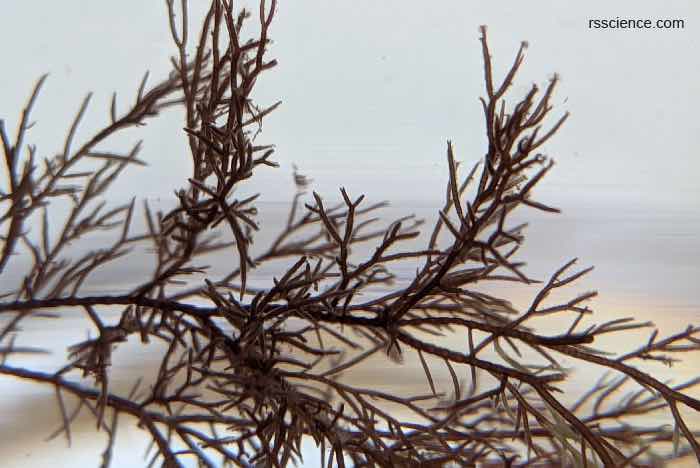
[In this image] Coral week, another kind of red algae.
Look at tide pool seawater under a microscope
There are many tiny microorganisms in a tide pool that are too small to be seen by naked eyes. For this reason, they are largely ignored when you visit a tide pool onsite. If you have a microscope at home, try to bring a cup of tidepool seawater to see what you can find.
[In this video] A few planktons that are barely seen by naked eyes. The big one at the center could be a crab larva. These small swimmers around are copepods.
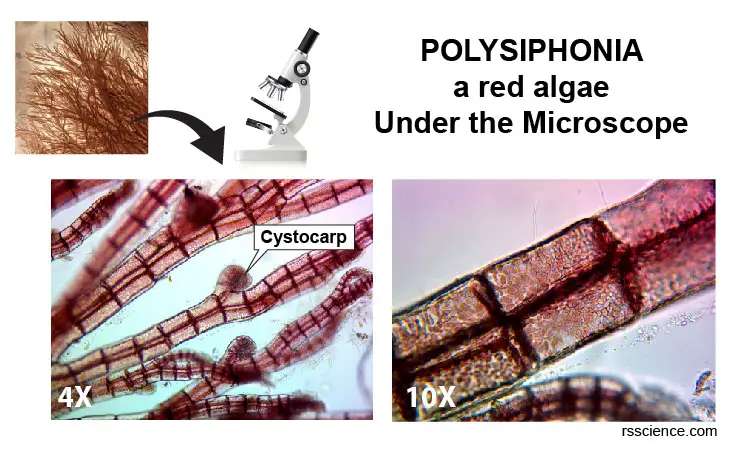
[In this image] Silky red algae (Polysiphonia sp.) under a compound microscope.
The bumps growing on the branches, called cystocarps, are the reproductive organ of red algae, which can produce carpospores.
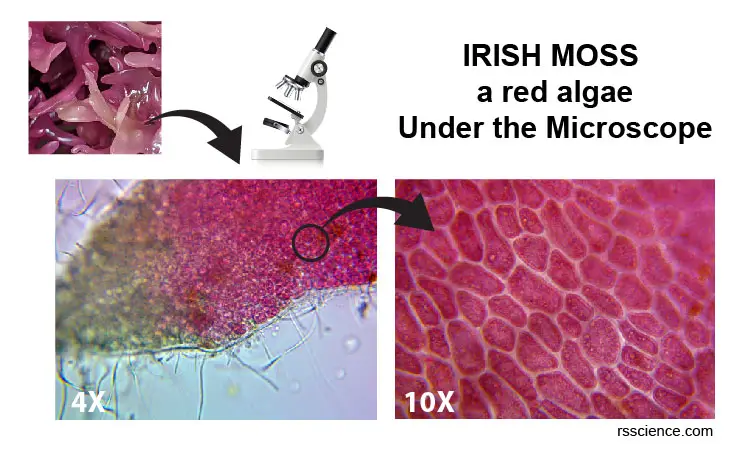
[In this image] Look at a piece of Irish moss under a compound microscope.
Under the 10x objective lens, you can see many red algae cells separated by white boundaries. Inside each cell is packed with many red pigment granules which make the algae look red.
You are sure to find many planktons. Planktons are the diverse collection of microscopic organisms found that are unable to propel themselves against a current. In the ocean, they provide a crucial food source to many small and large aquatic organisms, such as bivalves, fish, and whales. Marine planktons include bacteria, archaea, algae, and protozoa. Some tiny floating animals, such as small crustaceans, larvae of shrimps and crabs, and even young fish are also parts of planktons.
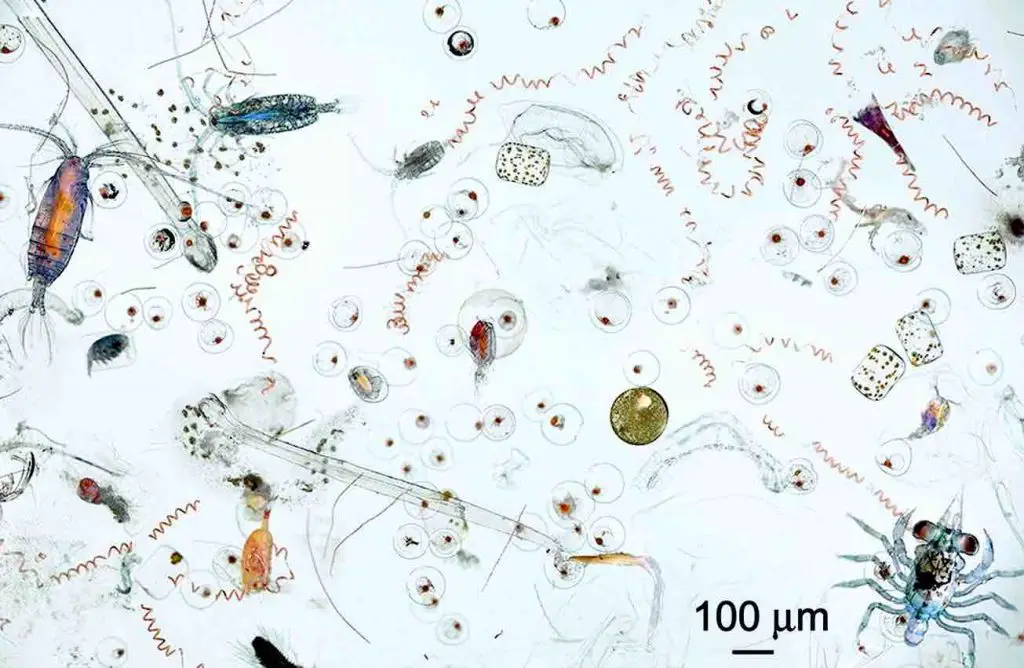
[In this image] The image contains diverse planktonic organisms, ranging from cyanobacteria, diatoms, amphipods, copepods, fish eggs, to crab larvae.
Photo credit: wiki
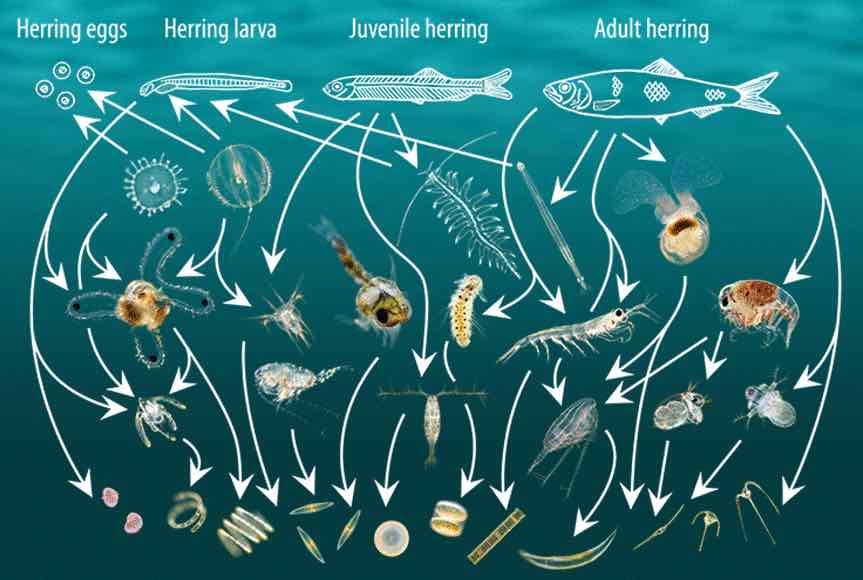
[In this image] The plankton food web.
The plankton is the food for fish, which in turn are eaten by other sea creatures such as seabirds, sharks, and seals, which are eaten by larger predators like killer whales.
You may find tide pool creatures unique to the local seacoast
In this article, we tried to include the common tide pool creatures you may find on the United States coastlines. However, this list doesn’t cover everything. In fact, there are varieties of ocean creatures worldwide; many of them exist only at a few habitations.
For example, in this video, they found tiny pufferfish, baby octopus, and even a sea snake. Baby lobsters and cuttlefish may hide under the rocks as well.

I even spotted a sea turtle in a rockpool in Hawaii!
Are you ready to explore your local tide pools?
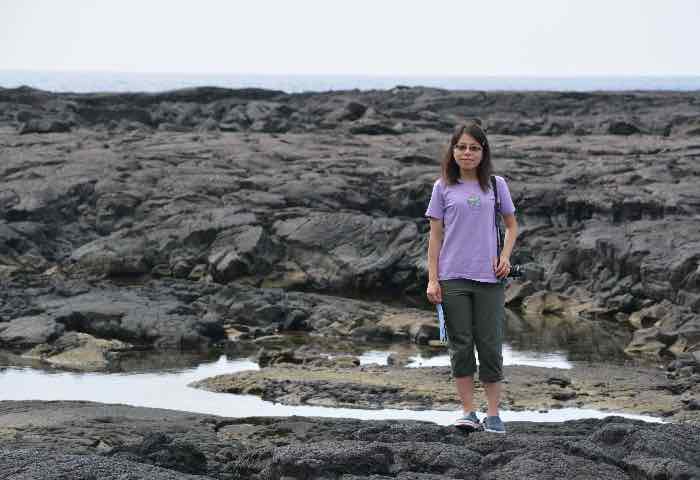
Pu’uhonua O Hōnaunau National Historical Park, Big Island, Hawaii
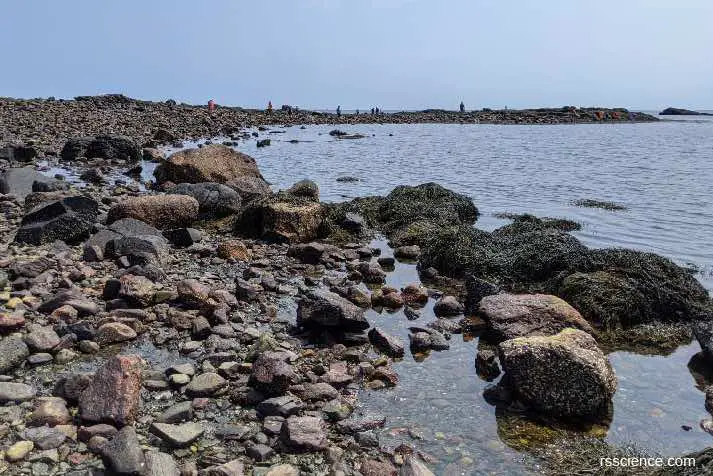
Odiorne Point State Park, Rye, NH
References
https://oceanservice.noaa.gov/welcome.html
California Tide Pools
“10 creatures you can find in a Maine tide pool”
“Tide pool ecosystems”
“Tide Pool Life”
“Tide Pool Seaweed”
“The Seaweed Site: information on marine algae”
“Marine Algae of Cape Cod, Massachusetts and Adjacent Islands”
“CZ-Tip – Learn What Lurks in a Massachusetts Tide Pool”

